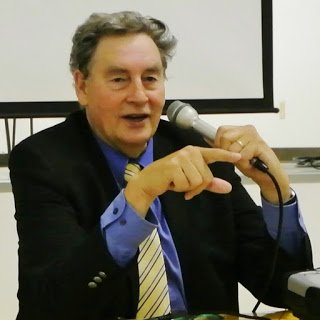Paul Connett delivered a tour de force on waste incineration, recycling and sustainability to the people of Warren and Washington Counties, NY, the site of an egregiously polluting garbage incinerator. Research by the Energy Justice Network (EJN) revealed that the facility in Hudson Falls burns 500 tons per day, yet it emits as much pollution as all the other incinerators in New York State put together, which burn thousands of tons per day each.
The event was sponsored by Clean Air Action Network of Glens Falls, CCAN, based in Glens Falls and chaired by long time Hudson Valley environmental activist Tracy Frisch and EJN, based in Washington, DC and Philadelphia directed by Mike Ewall. Connett is a veteran of the original effort to stop the incinerator from being built in 1986.
After decades of successfully stopping garbage incinerators from being built, activists are now setting their sites on closing existing, out of date, expensive and polluting facilities.
Any presentation by Connett, a retired professor of chemistry at St. Lawrence University in Canton, NY is an opportunity to learn, get motivated and have fun all at the same time. Rick Anthony, chair of the Zero Waste International Alliance, has dubbed Paul a Super Star of Zero Waste. He is an iconic speaker who describes complex issues of chemical pollution and its impacts on nature and humans, has total command of the history of how the garbage mess came about, with potent examples and experiences that we all can relate to and empathize with. He is an indefatigable traveler to 69 countries on every continent and 49 of our 50 states, accumulating knowledge about alternatives to incineration and the people who are creating ‘pieces of zero’ from all over the world. Unlike other Super Stars Connett does not have hundreds of millions of dollars. In 40 years of effort he has never charged for his time and expertise. Cost of travel, a clean bed, a nice dinner and a glass of (fine) wine and good company is his standard fee. Connett has documented a good deal of his and other anti incineration and Zero Waste campaigners in his 2013 book, Zero Waste: Saving the Planet One Community at a Time. He has also produced a documentary video entitled “Pieces of Zero” comprised of interviews with activists and practitioners.
Connett works closely with his wife Ellen Connett. They were a critical component of the anti garbage-burning network that stopped over 300 incinerators from being built through grass roots organizing. Ellen diligently reported the news in her Waste Not Newsletter on each and every on-going battle. Her news clips inspired others, provided contacts and shared strategies to pass on to organizers in newly threaten communities. Waste Not was a ‘Committee of Correspondence’ long after our Revolutionary Era and long before Internet communications.
Here is the gist of what Paul said. But you should review the entire presentation and follow up discussion.
- Over consumption drives the need for linear extraction of resources, water and energy and related pollution.
- Burning and landfilling waste leads back to more extraction and production of replacement products.
- Incineration is the last gasp of a linear economic system.
- Waste to energy is a waste of energy despite the use of energy production as incinerations main selling point.
- Ash and air pollution is the result of incineration.
- Government agencies rely of false data due to insufficient regulations, lack of testing, manipulated test results, minimal enforcement and collusion with ‘incineration consulting experts’.
- The impacts on human health are far worse than reported. Up to date research indicates that pollution impacts from burning garbage is far worse than previously thought. Dangerous nano-particles, which carry pollution into the body, are not regulated.
- Persistent pollutants enter the food chain. Contamination of dairy products in particular is alarming, yet go unreported. Ingesting contaminated food is far more dangerous than breathing polluted air. Drinking one litter of cows milk raised near a garbage incinerator is equivalent of breathing polluted air for 8 months.
- Dangerous chemicals enter the blood stream, are spread throughout the body and penetrate brain tissue.
- Zero Waste is spreading around the world, look to Italy as a model of anti incineration activism and Zero Waste implementation. Italian cities have reached 80% diversion from the waste stream.
- The key steps to Zero Waste
- Source separation
- Door to door collection
- Compost
- Recycling
- Reuse
- Zero Waste Resource Centers
- Economic incentives
Connett concludes with a message to stakeholders:
- To Elected Officials — have faith in people not machines,
- To Citizens — educate yourselves and organize,
- To Activists — don’t get depressed, use common sense and HAVE FUN!
View Connett’s complete lecture and follow up discussion below:
There is also a recent 10-minute podcast interview with Paul Connett about the Hudson Falls incinerator, thanks to Mark Dunlea and the Sanctuary for Independent Media in Troy. We suggest you use this as a teaser to introduce people to Paul Connett and interest them in his full-length presentation.
DISCLOSURE: I must report that the evening was NOT perfect. No presentation by Paul is complete without the audience joining in as Paul leads in singing the “Paul Connett’s Anti-Incineration Anthem” (sung to the tune of Battle Hymn of the Republic). I was terribly disappointed. However, we do have Paul doing a solo during a podcast coordinated by ILSR’s Nick Stumo-Langer. Join him in song and in fun as we end garbage incineration and reach for Zero Waste.





